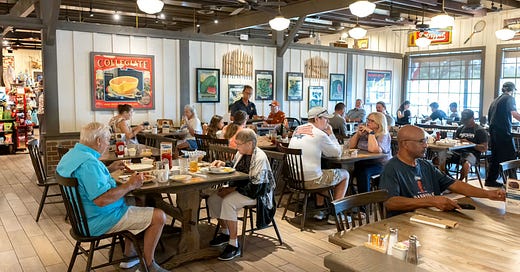Cracker Barrel, Nostalgia, and the Perils of Experience-Light Transformations
Our Review of the Wall Street Journal article
Cracker Barrel, Nostalgia, and the Perils of Experience-Light Transformations
"There is precious little in their three-year transformation to talk about that had anything to do with experience." — Joe Pine
In this week’s episode of the Experience Strategy Podcast, we dig into a recent Wall Street Journal article detailing Cracker Barrel’s efforts to modernize its brand. From lighter walls to new menus and pricing strategies, Cracker Barrel is aiming for a revival — but is it doing so at the cost of the experience?
The Heart of the Matter: What Makes Cracker Barrel, Cracker Barrel?
As Aransas puts it, Cracker Barrel is a “beloved legacy brand” — one that evokes deep nostalgia, particularly in the South. It’s not just a restaurant; it's a ritual. It's front porch rocking chairs, tabletop games, and tightly packed aisles of kitschy merchandise.
But we noticed a major gap in Cracker Barrel’s transformation: there’s virtually no focus on experience strategy. There’s the lack of attention to customer interaction, wait-time engagement, dramatic staging, or emotional markers that define compelling experiences. And what about the quirky retail setup — narrow aisles and all — is part of what makes it feel like home.
From Experience-Led to Brand-Led: A Risky Trade
Cracker Barrel’s transformation appears to be brand-led — emphasizing visual updates and demographics over customer jobs-to-be-done or emotional connection. Historically, Cracker Barrel was experience led.
Rather than merely brightening the place or revamping menus, we argue that Cracker Barrel could lean into its greatest asset: multi-generational connection. A space where grandparents and grandkids gather should nurture ritual, memory, and meaning — not strip it away.
Missed Opportunities and Fresh Ideas
One standout missed opportunity? The “campfire meals” concept. We think the experience should go further with Cracker Barrel locations with outdoor fire pits where families cook together — giving customers a mini-vacation, not just a meal. That’s the kind of transformation rooted in experience strategy: emotionally resonant, immersive, and memorable.
And what about employees? The Wall Street Journal piece barely mentions them. But transformations fail when employees don’t buy in. If they don’t believe in it — or worse, feel it alienates loyal regulars — the transformation risks collapse from within.
A Changing Customer, A Shifting Economy
The article also touches on how economic shifts, like tariffs and inflation, make Cracker Barrel’s price-conscious model newly relevant. But will aesthetic updates be enough to meet a more discerning customer base? It may very well be that a recession could help Cracker Barrel, by introducing its low-cost position to new cost-conscious customers, while enhancing the experience, not minimizing it.
🎁 A Special Invitation
This episode was recorded during the final summit of the Experience Strategy Collaboratives — a year-long program to help strategists design better experiences. We're giving away one free membership (a $35,000 value!) to a lucky podcast listener. 🎉
To enter, subscribe to our Substack and fill out the entry form by June 30, 2025.
📣 Let’s Keep the Conversation Going
We’d love to hear your take. What would you do to transform Cracker Barrel’s experience? Did we miss a key opportunity or get it spot on?
Until then, keep creating experiences that matter.
— Aransas, Joe, and Dave









I believe the transformation is perfect. Cracker Barrel still has the heart of hospitality still avaliable. Many restaurants don't have that experience! It's all about the guest and their family and dining experience! The changes have been thought out and are currently making the Brand a better place for every guest!